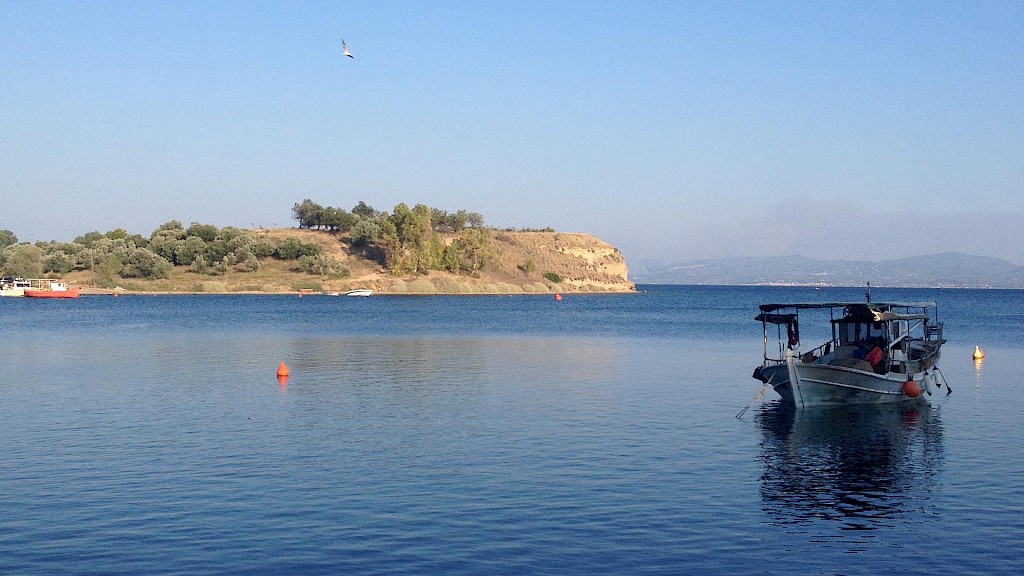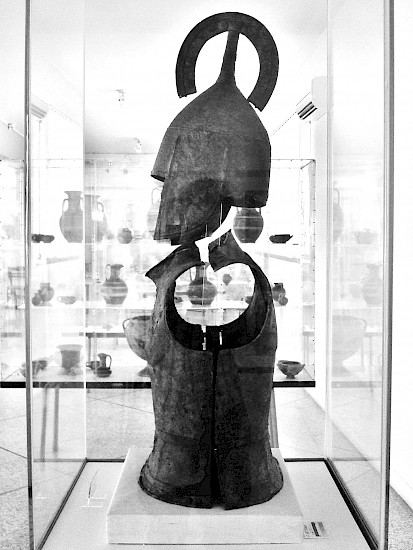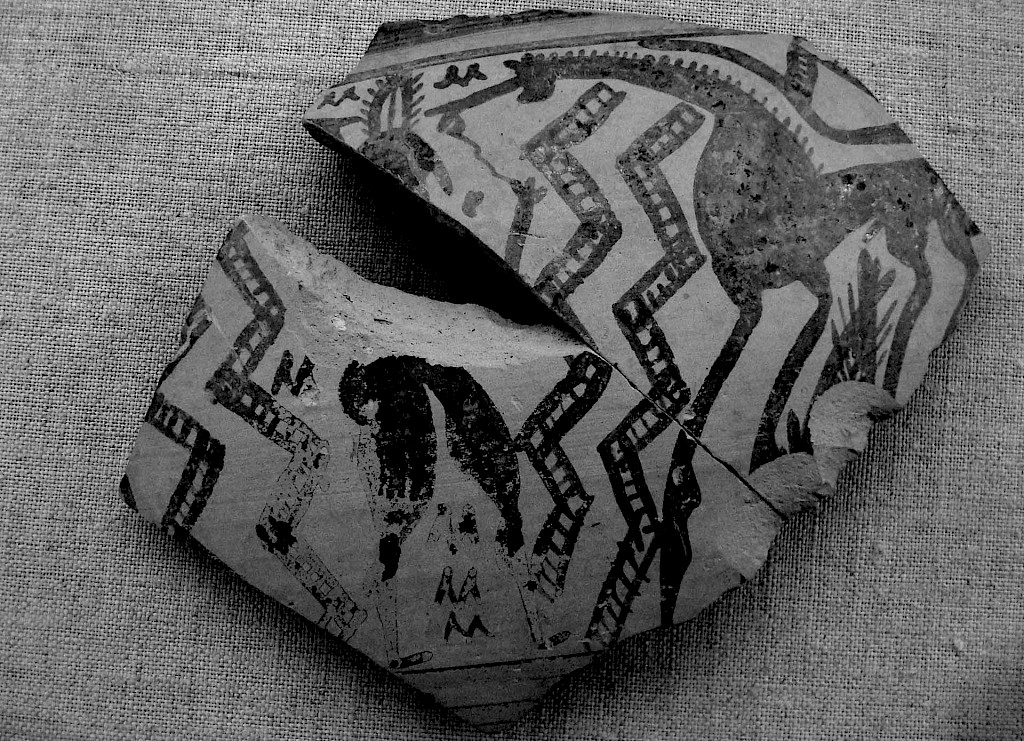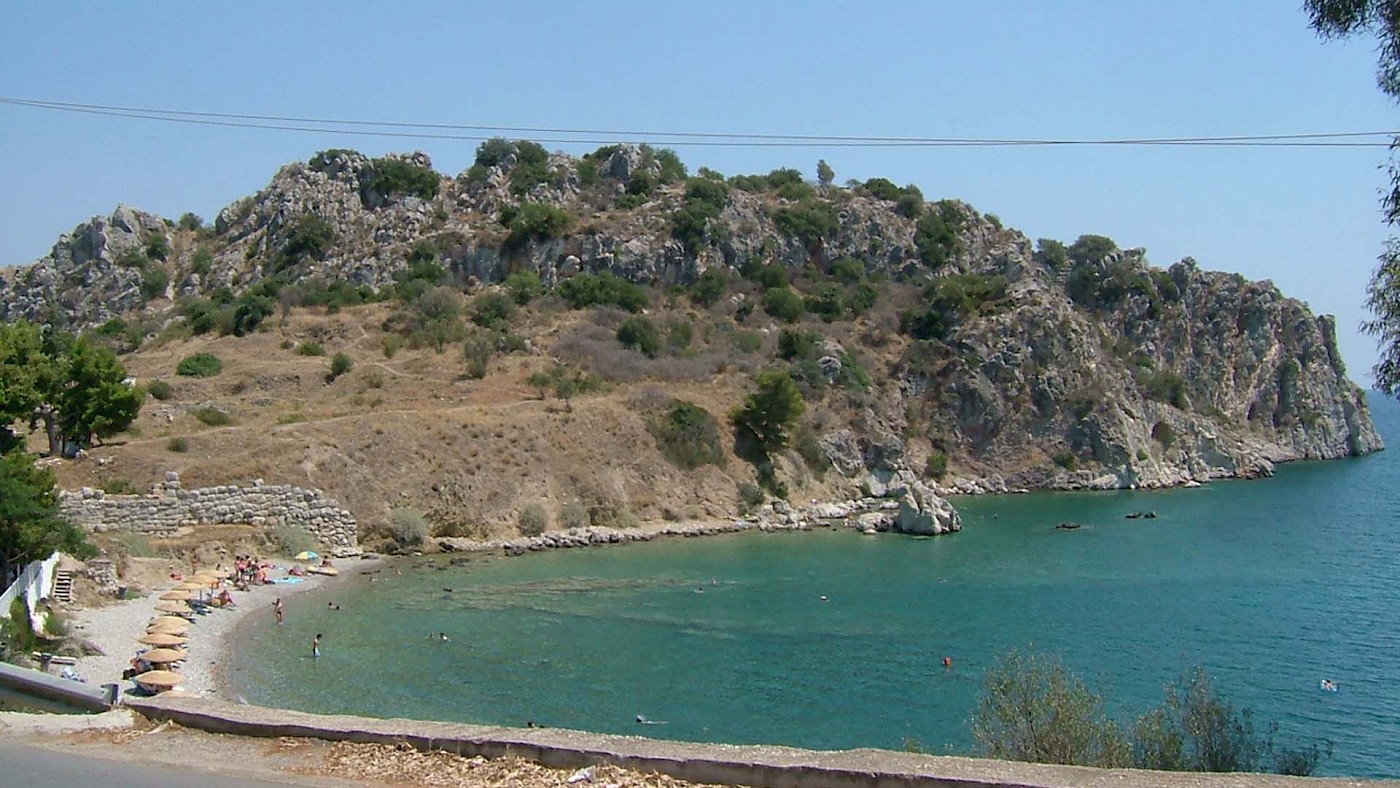In the late eighth century BC, Asine, a settlement in the southern Argolid, was destroyed and apparently abandoned. According to much later sources the aggressor was nearby Argos, and archaeological evidence seems largely to confirm this belief (Strabo 8.6.11; Pausanias 2.36.4-5). At around the same time, the latest known buildings on Xeropolis at Lefkandi were abandoned, one destroyed by fire, while around fifty years earlier the excavated areas of Nichoria in Messenia were burned to the ground.
These destructions are significant as they are among the first conflicts behind which we can begin to reconstruct the historical circumstances and the agents responsible. The previous major destructions of the Aegean world were those of the Mycenaean Palaces around 1200 BC, which were followed by a post-palatial century which saw many sites destroyed.
But in contrast to the complex and debated circumstances of the destruction of the palaces, in the case of Asine archaeological evidence, in combination with the literary sources, allows us to reconstruct some of the political circumstances not only of the site which had been destroyed, but also the possible motive of the probable aggressor, Argos (Guy D. Middleton, The Collapse of Palatial Society in LBA Greece and the Postpalatial Period (2010) is a fairly recent discussion that is available on Middleton’s Academia.edu profile; discussion of the Mycenaean collapse also forms part of his recent essay for Aeon).
Before looking to Asine, however, it is useful to consider the contrasting cases from other sites apparently destroyed in the late eighth century, to show the potential pitfalls of such an analysis as well as the opportunity presented by Asine.
The destruction of Nichoria
The earliest of these destructions is that of Nichoria in the middle of the eighth century. At the beginning of the century the settlement had been re-organized around Unit IV-5, a large building believed to have served an administrative or communal function and successor to several other large buildings in the area. Around 750, the oak superstructure of Unit IV-5 burned to charcoal and the building collapsed; furthermore, the excavated area around the building was covered with ash.
For the excavators, the historical context of this destruction was clear: around 750, the Spartan King Telekos was believed to have been campaigning in Messenia at the beginning of the First Messenian War: he must have led the forces which destroyed Nichoria. Further evidence adduced to support this argument is one of very few burials known from eighth-century Messenia: a pithos burial containing an iron sword; a warrior who lost his life in one of the early campaigns of the war.
The association between the destruction of Nichoria and the First Messenian War is an example of what Anthony Snodgrass has called the “positivist fallacy”: the belief that what is archaeologically visible is historically significant. If we consider the archaeological and historical evidence separately, it seems unlikely that a site as loosely organized and sparsely populated Sparta could have been making substantial territorial gains in the eighth century, especially at a site as far away as Nichora; it is questionable how feasible the military campaigns attributed to Telekos were for any settlement in eighth-century Greece.
As for the literary evidence the main source for the conquest of Messenia is Pausanias, writing some nine-hundred years after the supposed fact. Modern scholars tend to consider Pausanias’ dates for the Messenian wars to be too high (Jonathan M. Hall, A History of the Archaic Greek World ca. 1200-479 BCE (2nd ed., 2014), pp. 184-186). Lists of victors in the Olympic Games suggest that Pausanias’ dates are a generation too high, but even these victor lists were not composed until the fifth century and were based on unknown sources (for further discussion, see Hall 2014, pp. 30-32). Finally, it is impossible to suppose that a writer in the second century AD escaped the reconstruction of Messenian history, including the narrative of the wars of conquest, after Messenia gained its independence from Sparta in the fourth century.
Nichoria is a good example of a site where attempts to correlate archaeological evidence with early Greek history are misleading and unhelpful. There are many other possible explanations for the destruction of the site, including intentional human agency, but the archaeological evidence does not support the identification of the aggressor as Sparta over local Messenian trouble. Furthermore, there is no particularly compelling reason to rule out an accident or natural disaster as the cause of this destruction. While it is not possible to completely disprove that Telekos of Sparta was campaigning in Messenia in the mid-eighth century, alternative explanations for the destruction of Nichoria are preferable until a more firm grasp of Spartan power in the eighth century can be ascertained.
The destruction of Lefkandi and its problems
The situation is similar, although not identical, at Lefkandi in Euboea. When originally excavated, Lefkandi appeared to have been destroyed at the end of the eighth century, a casualty attributed to the greatest internal war of Aegean prehistory: the Lelantine War between Chalcis and Eretria, the major Euboean power centres of eighth-century Greece.
You can read about the Lelantine War in Josho’s article about it, here I will briefly summarize: Thucydides mentions that there was once a war between Chalcis and Eretria that was the “best exception” to the rule that early Greek wars were simple, local affairs; on association with Hesiod and Archilochus, it has been dated to the late eighth century. But most of the details are from much, much later sources such as Plutarch, and the contemporary evidence is slim (see also Hall 2014, pp. 1-8). In the case of Archilochus, we might also note that the surviving fragment that has been connected to the war survives via Strabo’s Geography, and yet the first-century writer makes no connection between this fragment and the Lelantine War, despite mentioning the war elsewhere in his work.

Further exploration of the settlement on Xeropolis suggests that reports of its destruction and abandonment at the end of the eighth century may be exaggerated. Only one building appears to have been destroyed by fire, while others excavated subsequently show no such damage; furthermore, its abandonment may actually date to the seventh century. But Thucydides’ testimony remains and some explanation is required to explain the decline in prosperity of the central Euboean settlements in the eighth century. It has been proposed that nothing but a dramatic war could have ended the dominance of Euboea.
However, an alternative proposition might note that from the late eighth century Corinth begins to dominate in the Aegean world, perhaps encouraged by its position on a gulf which allows direct access to the fledgling Greek colonies in Italy – such a proposal also makes sense of the supposed expulsion by Corinthians of Eretrian settlers on Corcyra, where the gulf meets the Adriatic, although no archaeological evidence supports the reality of this event (Plutarch, Greek Questions 11). It is likely, however, that with an ascendant Corinth in a better geographical position, there is no need for a Lelantine War to bring Euboea to its knees or destroy Lefkandi.
The Euboean gulf
The sites on the Euboean gulf were particularly prominent after the collapse of the Mycenaean palaces, when sea traffic was largely internal. The Euboean gulf not only allows access to the north and south Aegean, from which point the east and central Mediterranean can be reached, but a coastal, insular site like Lefkandi almost necessitates naval connectivity. From the tenth century at the latest Euboea was increasingly active in overseas activities which will have relied on navigating – and perhaps even controlling – the straits, but it was not the only site on either side of the gulf to prosper: particularly prominent are the sites of Kynos and Mitrou, in east Phocis, which link the prominent EIA sanctuary site of Kalapodi to the Aegean.
Archaeological excavation at Kynos and Mitrou has revealed material connections to Lefkandi, as well as strong evidence that seafaring along the gulf was no easy endeavour. From twelfth-century Kynos a number of kraters are known which depict scenes of combat taking place on ships. Meanwhile, excavations at Mitrou have revealed evidence of destruction at the site in the mid-tenth century.
The evidence from Kynos and Mitrou can be interpreted in a number of different ways. A positivist approach would suggest that the evidence supports recurrent conflict amongst the communities of the gulf, whether with one another or other, piratical groups hoping to gain from the most prosperous regions of the Aegean in the Early Iron Age [see also Kramer-Hajos]. Roughly contemporary with the destruction at Mitrou, the so-called “heroön” at Lefkandi is constructed and dismantled as part of the burial rites of a warrior; this is followed by a century-long sequence of “warrior burials” at Lefkandi.
On the other hand, critical examination of the evidence from Mitrou reveals that only one building is known to have been destroyed – the same kind of limited evidence which has led to questions of the reality of the destructions at Lefkandi and Nichoria. However, the burning of the building is subsequent to, and thus cannot be responsible for, its collapse; furthermore, the building was not emptied prior to its destruction, suggesting that it was not abandoned first. But we cannot show why it collapsed, and to assume from this limited evidence that the whole site was destroyed is methodologically flawed. Further excavations may clarify these issues. But at this point we cannot be certain that Mitrou was intentionally attacked, nor can we ever be sure of the identity of the attackers.
The destruction of Asine and its problems
What, then, is different when we turn to the Argolid and the destruction of Asine? The historical sources remain late, with most information originating with Pausanias; in Strabo’s discussion of Asine he makes reference to the fourth-century historian Theopompos, the most closely contemporary literary source, some three-and-a-half centuries after the fact. However, archaeological evidence confirms that the site was destroyed and largely abandoned in the late eighth century, while the adoption of the cult of Apollo Pytheus in Argos at around this time has been taken as confirmation that this site was the aggressor, allowing the comparison of both the site destroyed and a probable attacker (Hall 2014, pp. 160-162).
There remains much in Pausanias’ account which must be dismissed. Argos is said to have destroyed Asine in retribution after the Asinaeans supported an invasion of the Argolid by Sparta; as a consequence, the Asinaean refugees were allowed to resettle in newly-conquered Messenia. The connection here is likely to be part invention, to account for the place-name Asine in Messenia, and part elaboration of the history of the conquest of Messenia after the Messenians gained their independence. Nino Luraghi has highlighted the resemblance of the alliances recorded for the Messenian wars to those after the battle of Leuktra (Nino Luraghi, The Ancient Messenians: Constructions of Ethnicity and Memory (2008), p. 79); this is not the earliest attestation of Argive/Spartan rivalry, but it makes sense for such vague histories to be drawn together into a more coherent whole. Strabo’s account claims that the Argives destroyed several other settlements in the Argolid with the somewhat dubious motive of “disobedience”; the chronological information on this point is vague, and archaeological evidence suggests that the destructions of Nauplia and Tiryns were certainly later, and again it is suspicious that the destruction of Asine is being tied so closely to other events about which much more appears to have been known.
Turning to archaeology, the evidence is more positive. Unlike the destruction of Nichoria, the supposed aggressor is local. There is a little evidence for continued occupation at Asine after the destruction, including the sanctuary of Apollo Pythaeus on the Barbourna hill, which suggests use of the adjacent fertile plain rather than a substantial settlement. In the destruction level itself, a single arrowhead was discovered – not much, but more of an indication that this destruction was violent than for any of the other late eighth-century destructions so far considered. Meanwhile, the size of the settlement at Argos in the late eighth century, the succession of burials including not only weapons but also body armour – not known in the Aegean since the Bronze Age – and the adoption of the cult of Apollo Pytheus after the destruction of Asine all indicate that Argos is a good candidate for the aggressor.
The Argolid in the Early Iron Age
The deeper history of the Argolid also sheds some light on events in the late eighth century. After the destruction of the Argive Mycenaean palaces ca. 1200, it is the then-coastal site of Tiryns which first prospers. However, after the twelfth century the Argolid largely appears to go into a comparative slump, with reasonable numbers of graves known, but few of comparable wealth to those at contemporary Lefkandi or even Athens.
The ninth and especially the eighth century see a revival, with absolute numbers of burials drastically increasing as well as the numbers of metal objects and imports, largely in Argos and Asine. While it is entirely possible that the excavation history of Mycenae and Tiryns has prevented full appreciation of their size in the Early Iron Age, and subsequent activity certainly limits what we know about ancient Nauplia, the number of known graves points more securely to the size and importance of Asine and Argos.
While it is possible to confirm our belief in some of what Pausanias has told us anyway, the further questions come from what he does not reveal, and what I have thus far rejected from his narrative, principally why and how Argos destroyed Asine. With the possible exceptions of Mitrou and Nichoria we have no evidence that large, nucleated settlements were even attacked during the centuries between the chaotic post-palatial period and the destruction of Asine and, even if we incorporate these two, Asine remains distinct as it is completely wiped off the map.

The Argolid provides the study of early Greek warfare with evidence unparalleled in any other contemporary settlement, which may point towards the reasons for Argos’ success. The first known bronze panoply since the Bronze Age was discovered in Tomb 45 at Argos; however, this is not the beginning but the culmination of the Argive tradition of burials with weapons, which is known from the ninth century. This is the best-known sequence of burials with weapons in eighth-century Greece after Athens abandons the practice early in the century and the known cemeteries at Lefkandi no longer receive burials towards the end of the ninth century. Two earlier eighth-century Argive burials contained helmets, one alongside scraps which may have been a breastplate.
One must not be fooled into thinking that burials with weapons represent weapons and armour as they would be used: Thucydides makes reference to swords as articles of dress in times gone by and Hans van Wees has reasonably proposed that many burials with weapons can be interpreted as daily dress rather than war gear (Hans van Wees, “Greeks bearing arms: the state, the leisure class, and the display of weapons in archaic Greece”, in: Fisher, N. and H. van Wees (eds.), Archaic Greece: New Approaches and New Evidence (2008), pp. 333-378). The short length of all of the swords recovered from Argive graves may support such an interpretation. The helmet and cuirass may not be interpreted this way, but comparable armour from central Europe is usually interpreted as ceremonial, not practical. In addition to this the helmet, which would balance precariously on the head of the wearer, may also be decorative.

Nonetheless, this armour takes its inspiration from a wide network of contacts and indicates that the Argives may have been innovative with their military equipment. Supporting evidence includes representations on pottery of the “master of horses”, often represented as a single human figure between two horses. On a number of vessels the Master is armed or armoured; at least one depiction includes a helmet which is remarkably similar to that found in Tomb 45. In addition to this, the Argolid includes some of the earliest depictions of mounted warriors in the round. Terracotta figures of figures on horseback occur in Argos, Asine, the Agamemnonion at Mycenae, Tiryns, and the Argive Heraion; these figurines are largely likely to date to the seventh century, but they may indicate the role of the Argolid in military innovations at around this time: some figurines also carry large, round shields, which may be depictions of the so-called “Argive” shield with porpax and antilabe.
These developments are not strictly Argive: as mentioned previously there are good reasons to suppose that the inspiration for the cuirass comes from Europe while the helmets closely resemble contemporary and earlier examples from the Assyrian Empire. Our knowledge of Argive overseas activities in the late eighth century is limited when compared to other regions, such as the neighbouring Corinthia and central Euboea. It is possible that these influences did not come directly to the Argolid. But it is here that they are found, as is the best evidence for their use in battle.
Different solutions, similar problems
In order to fully understand the significance of the destruction of Asine the wider context of the late eighth-century Aegean needs to be taken into account. I’ve described in a previous article the abandonment of the sites of Zagora and Hypsele on Andros ca. 700. Like Asine, Lefkandi, and Nichoria, the archaeological preservation of Zagora and Hypsele is largely down their abandonment at the end of the eighth century.
Explanations for their abandonment have ranged from earthquakes to the disruption caused by the Lelantine War, but an absence of movable objects or completely preserved pots in the ruins of Zagora suggest that the inhabitants chose to abandon that site, at least. The evidence for the foundation and expansion of a third site on the island, the city of Andros (modern Palaiopolis), suggests an alternative explanation: synoikismos, the merging of several communities into one polis.
The island of Andros provides an interesting contrast to the Argolid in the late eighth century. In each of these regions decisions are being made on a community-wide level. If Zagora and Hypsele were both abandoned in agreement with one another, then a group must have had the authority to command the inhabitants to do so. Their power may not have been absolute, as Hypsele was not completely abandoned until the sixth century, but the settlement arrangement there and at Zagora suggest close communities as early as the ninth century. These settlements are beginning to organize themselves on a much greater scale. The flipside to this approach can be seen in the Argolid: other settlements are becoming threats to communities as they come to establish themselves. In one region co-operation is observed; in the other, conflict.
Abandoned places
These sites can be connected together in a number of ways, perhaps best summed up by their failure: they are all losers. Asine, certainly, appears to have lost a war, but even Zagora and Hypsele must have ultimately come to the conclusion that they cannot survive as they are. Lefkandi fits between the two, perhaps loser in a war, perhaps located in a position which has become a failure; like Mitrou, it may be the case that it has to be removed so that another power can dominate the Euboean Gulf.
With the exception of Nichoria, these losing sites have another thing in common: they are all coastal, specifically located at least in part on a plateau or tell which protrudes, steep-sided, into the sea. Except Mitrou, large walls have been excavated at each site across the isthmus connecting them to the mainland, perhaps indicating that they suspected trouble, but perhaps also that they were able to cause it. Asine, Lefkandi, and Mitrou could all disrupt sea traffic in their respective areas – Jonathan Hall suggested that it was necessary for Argos to destroy Asine to prevent piracy. It is perhaps better to say that Asine controlled access to the Aegean Sea from the Argolic Gulf, and thus controlled Argive connectivity to the Mediterranean world in this important period of expanding horizons.
Argos does not appear to have been disconnected from the wider world prior to the destruction of Asine, as seen earlier when looking at the origins of the armour in its graves. But the clearest relations Argos had were over land, to Olympia where Argive bronze figurines are known in abundance, and it was perhaps here that the Argives came to see the control that coastal Asine had over them.
How successful a move it was for Argos to destroy Asine is unclear, as the archaeological record for the seventh century BC is patchy, seeming to reflect a period of austerity. There is no further “orientalizing” in Argive material culture, although there are a number of Corinthian imports. In the long term, however, Argos became one of the most significant poleis of the Greek world.
The wider context
On the wider scale, the destruction of Asine suggests a larger scale of warfare, but perhaps also a decline in violence. Its destruction was greater than that of Mitrou, Nichoria, or even Lefkandi – by human hands or otherwise – for at those sites only a few building were destroyed and there is evidence for reoccupation.
But while all of these sites were offered some protection by walls, none of their replacements appear to have been immediately fortified; many Greek cities would not be until the later seventh and sixth centuries. Other evidence also points to the increasing scale and organization of warfare: the polyandrion at Paros includes one-hundred and twenty dead young men, but also organization in collecting, cremating, and burying their remains in a mass grave.
Warfare, therefore, is indicative of the development of the ideas behind communities and their protection, exemplified furthermore by the consolidation of Zagora and Hypsele. But the destruction of Asine, and perhaps other sites, indicates a darker element to this trend. While the inhabitants of Andros were identifying as a unit, together, the inhabitants of the Argolid began to see themselves as competing groups, which ultimately led to destruction.
This article’s featured image is a photograph of Asine.
